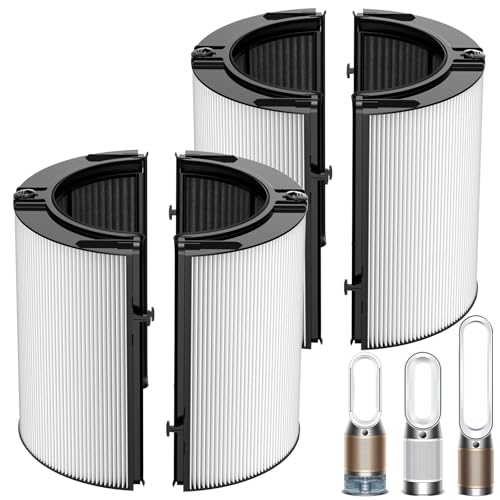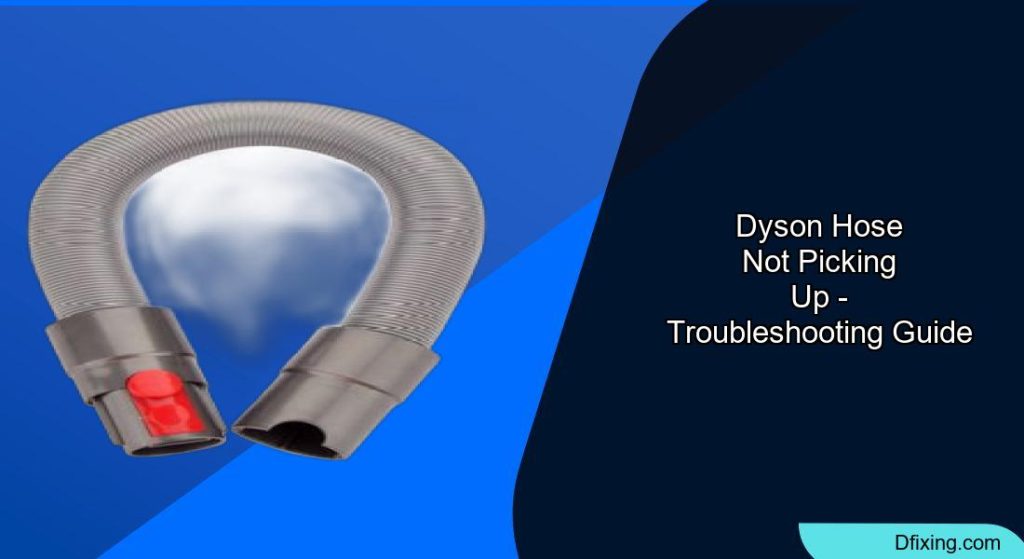When your Dyson vacuum’s hose stops picking up debris, it can transform a quick cleaning session into a frustrating experience. This common issue affects many Dyson owners but can typically be resolved through proper troubleshooting and maintenance. The loss of suction through the hose significantly compromises your vacuum’s cleaning power, leaving dirt and debris behind despite your best efforts.
Dyson Vacuum Deals
⏰ Limited Stock!Affiliate disclosure: As an Amazon associate, We'll earn a commission for every successful order through our affiliate links in the article. However, you won’t be charged anything for this.
In this comprehensive guide, we’ll explore the various causes behind a non-functioning Dyson hose and provide detailed, step-by-step solutions to restore your vacuum’s performance. From simple blockages to more complex mechanical issues, we’ll cover all potential problems and their fixes, helping you avoid unnecessary service calls and extend the life of your Dyson vacuum.
Common Causes of Dyson Hose Suction Loss
The first step to fixing your Dyson’s hose is identifying what’s causing the problem. Several factors can contribute to suction loss:
Blockages in the System
Blockages are the most common culprit when your Dyson hose stops picking up debris. These obstructions can occur in various parts of the vacuum:
- Hose blockages: Hair, string, or larger debris items can get lodged inside the hose
- Wand obstructions: Debris can accumulate in the rigid extension wand
- Intake port clogs: The connection points between components often trap debris
- Main airflow pathway restrictions: Blockages can occur throughout the vacuum’s internal channels
Many users have reported finding unexpected items causing blockages, including socks, pens, small toys, and even golf tees lodged in critical airflow passages.
Filter Problems
Your Dyson’s filters play a crucial role in maintaining proper suction:
- Clogged pre-motor filter: This primary filter protects the motor but can become saturated with fine dust
- Dirty post-motor filter: The secondary filter can restrict airflow when clogged
- Improperly seated filters: Filters that aren’t correctly installed create air leaks
Neglected filter maintenance is a leading cause of performance issues in Dyson vacuums.
Component Wear and Damage
Over time, physical components can deteriorate:
- Cracked or split hose: Even small tears significantly reduce suction power
- Damaged seals: Worn gaskets and seals allow air to escape
- Worn brush roll: A failing brush roll affects overall cleaning performance
- Stretched or broken belts: Drive belt issues impact suction at the cleaner head
Mechanical Failures
Some suction problems stem from mechanical issues:
- Malfunctioning changeover valve: This critical component directs suction between the cleaner head and hose
- Stuck flap mechanisms: Flaps that fail to open or close properly disrupt airflow
- Motor problems: While less common, motor issues can affect suction power
Comprehensive Troubleshooting Process
Inspecting and Clearing the Hose
Follow these steps to check for and remove blockages in your Dyson’s hose:
- Detach the hose completely: Unplug your vacuum and disconnect the hose from both the main unit and wand.
- Visual inspection: Look through the hose from both ends to spot any visible blockages.
- Tap test: Gently tap the hose over a trash can to dislodge loose debris.
- Flashlight check: Shine a light through the hose to identify less obvious obstructions.
- Manual clearing: For stubborn blockages, use a broom handle or flexible cleaning tool to carefully push through obstructions (avoid using sharp objects that could damage the hose).
- Check for damage: Examine the entire length of the hose for cracks, splits, or holes that might cause suction loss.
If the hose is damaged, then it should be replaced.

Premium multi-model replacement with enhanced durability

Genuine DC14 hose for reliable performance

Genuine DC07 with extended reach

OEM part for DC41 and DC65 models
If your hose shows signs of significant damage, replacement may be necessary. For the Dyson DC41, for example, replacing the hose involves unplugging the vacuum, removing the wand, detaching the canister, and pressing the catch at the hose base to remove it.
Examining and Cleaning Filters
Proper filter maintenance is essential for maintaining suction:
- Locate all filters: Dyson vacuums typically have a pre-motor filter (usually near the dust bin) and a post-motor filter (often at the base or side of the machine).
- Remove filters carefully: Follow your model’s specific instructions for filter removal.
- Assess filter condition: Heavily soiled filters will appear discolored and clogged with dust.
- Washing washable filters:
- Rinse under cold water until the water runs clear
- Gently squeeze to remove excess water
- Allow to dry completely for at least 24 hours before reinstalling
- Replace non-washable filters: Some Dyson models have HEPA filters that must be replaced rather than washed.
- Proper reinstallation: Ensure filters are completely dry and properly seated to prevent air leaks.
If your filter is non-washable and needs replacing, then you can find it here.

Official Dyson replacement for V11/V15 vacuums

Budget-friendly replacement for multiple tower purifiers

Premium filtration for Pure Cool/Hot+Cool models

Upgraded 2-in-1 design for humidify/purify models
For optimal performance, clean washable filters every 3-6 months depending on usage frequency.
Checking the Changeover Valve
The changeover valve is a critical component that directs suction between the cleaner head and hose:
- Access the valve: Remove the cleaner head and, if necessary, the dust bin to locate the changeover valve.
- Inspect for obstructions: Look for debris caught in or around the valve mechanism.
- Test valve movement: The valve should move freely between positions. If it’s stuck, carefully free it from any debris.
- Check for damage: Examine the valve for cracks or other damage that might affect its function.
- Verify proper operation: With the vacuum running, test whether suction switches properly between the cleaner head inlet and the hose.
Many users report finding objects trapped in this area that prevent proper valve operation.
Examining the Small Suction Hose
Many Dyson models have a small auxiliary suction hose that can cause problems:
- Locate the small hose: This is typically found at the back of the machine and may have a red cap.
- Check connections: Ensure it’s properly attached at both ends.
- Inspect for damage: Pull the hose out slightly and check for rips or tears.
- Clear any blockages: Remove any visible debris that might be restricting airflow.
Checking Brush Roll and Belt Condition
Issues with the brush roll can affect overall vacuum performance:
- Remove the cleaner head: Turn the vacuum over and detach the cleaner head according to your model’s instructions.
- Inspect the brush roll: Look for hair, string, or debris wrapped around the brush.
- Clean the brush thoroughly: Remove any entanglements and clear the brush housing.
- Check the belt: Examine the drive belt for stretching, cracking, or breakage.
- Test brush rotation: When reassembled, the brush should spin freely when the vacuum is on.
Model-Specific Troubleshooting
Dyson Ball Multi-Floor/DC25
These models require specific attention to:
- Gold-pronged filter housing: Access this using the red clip. Slide the clip off, release the hook, and remove the filter to check for debris.
- Brush area maintenance: Flip the housing tabs and clear hair/debris from the brush assembly.
- Deep hose clogs: After removing the canister, lift the flip-up panel on the hose and use needle-nose pliers to carefully extract stubborn blockages (avoid damaging the liner).
Dyson Animal Series
For Animal models, pay special attention to:
- Change valve access: Inspect the secondary filter on the left-hand side to access the change valve near the hose connection.
- Valve operation: Clear any obstructions preventing the valve from shifting between wand and roller head suction modes.
- Pet hair accumulation: These models are particularly prone to hair buildup in the brush roll and hose.
Dyson DC07
This older model has specific considerations:
- Filter differences: Clean the washable pre-motor filter and replace the non-washable post-motor filter if clogged (HEPA models have a distinct design).
- Valve pipe inspection: Check the valve pipe thoroughly for obstructions.
- Hose integrity: Examine the main hose carefully for nicks or splits that develop with age.
Preventive Maintenance Practices
Regular Cleaning Routine
Implement these practices to prevent future suction problems:
- Empty the dust bin after each use: Never let the bin fill beyond the maximum line.
- Monthly filter checks: Inspect filters regularly, even if you’re not yet due for a cleaning.
- Quarterly deep cleaning: Perform a thorough inspection of all components every three months.
- Brush roll maintenance: Clear the brush roll of hair and fibers weekly if you have pets.
- Hose and valve pipe inspection: Check these components monthly for early signs of blockages.
Best Practices for Vacuum Operation
Proper usage helps prevent problems:
- Use appropriate attachments: Select the correct tools for different surfaces and cleaning tasks.
- Avoid overloading: Clean high-debris areas gradually rather than attempting to vacuum large amounts at once.
- Handle with care: Don’t yank or stretch the hose, as this can damage internal wiring and connections.
- Proper reassembly: Ensure all components, especially those with tabs or clips like the red tab on the hose, are fully engaged during reassembly.
Frequently Asked Questions (FAQ)
Why does my Dyson have suction at the main unit but not through the hose?
This typically indicates a blockage in the hose itself or at the connection points. It could also signal a problem with the changeover valve that directs airflow between the cleaner head and hose. Check both the hose for obstructions and the valve mechanism for proper operation.
How often should I clean my Dyson filters?
Dyson recommends washing filters every 3-6 months under normal household use. However, if you have pets or vacuum frequently, consider cleaning them more often. Always allow filters to dry completely (at least 24 hours) before reinstalling them.
Can I repair a damaged Dyson hose?
While temporary fixes like tape might work briefly for small cracks, they’re not long-term solutions. Replacement hoses are available from Dyson directly or authorized retailers. The replacement process varies by model but typically involves detaching the old hose at connection points and installing the new one.
Why does my Dyson lose suction after a few minutes of use?
This could indicate overheating due to blockages or filter issues. When Dyson vacuums overheat, they often reduce power automatically as a protection mechanism. Clear all potential blockages, clean or replace filters, and ensure the vacuum has proper airflow throughout all components.
Is it normal for my Dyson to make a high-pitched noise when using the hose?
No, unusual noises typically indicate a partial blockage or restricted airflow. A high-pitched whistling sound often means air is being forced through a small opening somewhere in the system. Check for partial blockages in the hose, wand, and all connection points.
Conclusion
A Dyson vacuum with hose suction problems can be frustrating, but most issues are solvable through systematic troubleshooting. By following the comprehensive steps outlined in this guide, you can identify and resolve the root cause of your vacuum’s performance issues without requiring professional service in most cases.
Regular maintenance is the key to preventing future problems. Establishing a routine cleaning schedule for your Dyson’s components—particularly the filters, hose, and brush roll—will help maintain optimal suction power and extend your vacuum’s lifespan.
Remember that proper handling and operation are equally important in preventing damage. By using appropriate attachments, avoiding overloading, and handling components with care, you’ll minimize wear and tear on critical parts like the hose and changeover valve.
With the right approach to troubleshooting and maintenance, your Dyson vacuum can continue to deliver the powerful suction performance it was designed to provide for years to come.










